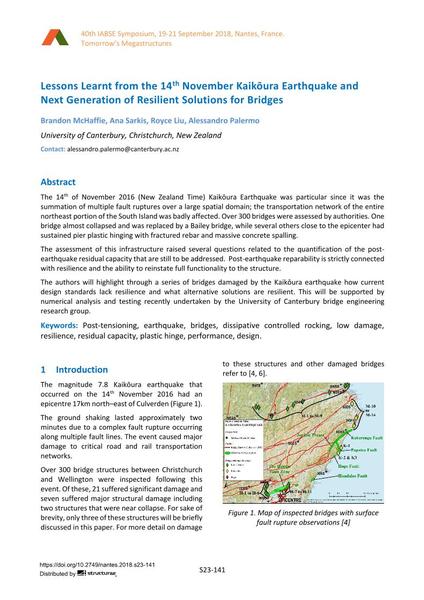Lessons Learnt from the 14th November Kaikōura Earthquake and Next Generation of Resilient Solutions for Bridges

|
|
|||||||||||
Bibliographic Details
| Author(s): |
Brandon McHaffie
(University of Canterbury, Christchurch, New Zealand)
Ana Sarkis (University of Canterbury, Christchurch, New Zealand) Royce Liu (University of Canterbury, Christchurch, New Zealand) Alessandro Palermo (University of Canterbury, Christchurch, New Zealand) |
||||
|---|---|---|---|---|---|
| Medium: | conference paper | ||||
| Language(s): | English | ||||
| Conference: | IABSE Symposium: Tomorrow’s Megastructures, Nantes, France, 19-21 September 2018 | ||||
| Published in: | IABSE Symposium Nantes 2018 | ||||
|
|||||
| Page(s): | S23-141 | ||||
| Total no. of pages: | 8 | ||||
| DOI: | 10.2749/nantes.2018.s23-141 | ||||
| Abstract: |
The 14th of November 2016 (New Zealand Time) Kaikōura Earthquake was particular since it was the summation of multiple fault ruptures over a large spatial domain; the transportation network of the entire northeast portion of the South Island was badly affected. Over 300 bridges were assessed by authorities. One bridge almost collapsed and was replaced by a Bailey bridge, while several others close to the epicenter had sustained pier plastic hinging with fractured rebar and massive concrete spalling. The assessment of this infrastructure raised several questions related to the quantification of the post- earthquake residual capacity that are still to be addressed. Post-earthquake reparability is strictly connected with resilience and the ability to reinstate full functionality to the structure. The authors will highlight through a series of bridges damaged by the Kaikōura earthquake how current design standards lack resilience and what alternative solutions are resilient. This will be supported by numerical analysis and testing recently undertaken by the University of Canterbury bridge engineering research group. |
||||
| Keywords: |
design bridges earthquake plastic hinge performance post-tensioning resilience residual capacity dissipative controlled rocking low damage
|
||||
